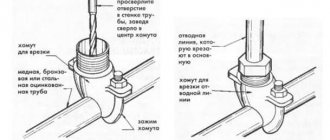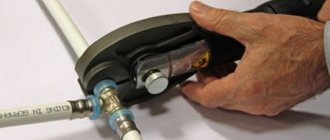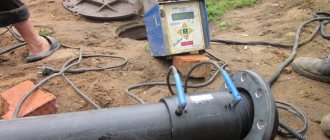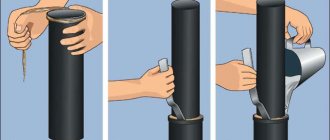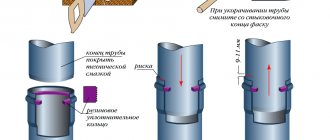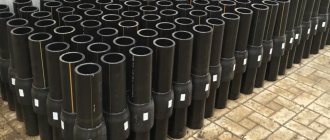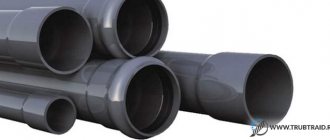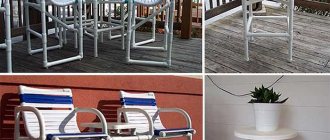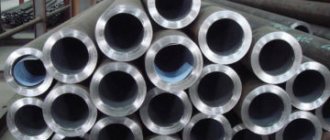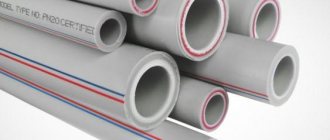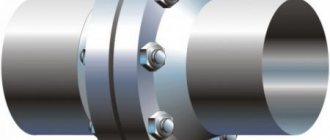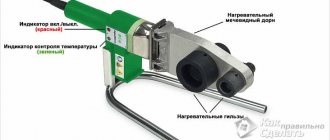Polypropylene pipes are used in the installation of water supply systems, for the installation of irrigation systems and for heating. The popularity of the material and various areas of use are due to its characteristics: strength, durability, ease of connection. An important argument in favor of polypropylene pipes was their price, which is significantly lower than that of metal-plastic or metal analogues.
The service life of a plastic pipeline with cold water is 50 years; such an impressive figure makes it necessary to replace outdated lines with this type of pipeline. The tightness of joints is the most important factor for any pipeline, therefore the viability of the system depends on the quality of installation. In the article we will talk about how to connect polypropylene pipes with metal, polyethylene, steel, and also consider various welding options.
Materials and tools
Soldering iron for welding
If you decide to save on installation services and do it yourself, then you need to buy or rent a special soldering iron with nozzles. In addition to this you will need:
- tape measure and marker for marking;
- scissors for cutting plastic pipes;
- cleaning for pipes.
There are several types of polypropylene pipes, which differ in their area of use:
- PN 10, 16 – used for laying cold water pipes;
- PN 20 - universal pipes with thick walls, they can withstand hot water at temperatures up to 80ºC, therefore they are suitable for heating installations;
- PN 25 is a composite pipe with a metal or nylon layer, which is peeled off during soldering. It is used for heating systems, the final heating temperature is 95°C.
Polypropylene pipes and fittings
A distinctive characteristic of connecting polypropylene pipes is the absence of joints directly between the pipes. If their diameter is less than 50 mm, all parts can be connected with fittings for various purposes:
- couplings - connect sections of the same diameter;
- crosses - used to create branches;
- plugs - seal the end of the pipe;
- adapters - used to connect pipes of different diameters;
- union fittings - connect to flexible hoses.
Anatomy of polypropylene pipes
Most polypropylene (PP) pipes are the same at first glance. A more detailed examination of them will allow you to notice differences in material density, internal structure and wall thickness. The scope of application of pipes and the features of their installation depend on these factors.
Classification of PP material
The quality of a polypropylene weld and the operational characteristics of pipes are largely determined by the PP manufacturing technology.
There are the following types of parts, based on the material they are made of:
- PRN . Single-layer products made of homopolypropylene. Used in industrial pipelines and cold water supply systems.
- RRV . Single-layer products made from PP block copolymer. Used for installation of underfloor heating networks and cold pipelines.
- PPR . Single-layer products made from random copolymer PP. They are used in water supply and home heating systems with water temperatures up to +70°C.
- P.P.S. _ Refractory type of pipes with operating temperatures up to +95 °C.
There are also multilayer reinforced PP parts.
When heated by 80 degrees, reinforced PP pipes elongate by 2-2.5 mm/m, and conventional single-layer pipes by 12 mm/m
They have an additional internal aluminum shell, which dramatically reduces thermal expansion, facilitating wiring installation and operational safety.
The disadvantage of these products is the need to remove the top polymer layer and aluminum to the depth of penetration of the pipe into the fitting before soldering.
We examined in more detail the types of PP pipes by material of manufacture and fittings in our other article.
What does the marking look like?
You can select the required pipes and fittings for plastic wiring in the construction market yourself. You just need to know the labeling symbols.
The indicators may be in a different sequence and in a foreign language, but store managers must know any decoding
To determine the scope of application of polypropylene products, the main indicator is PN. This is an indicator of the nominal pressure in kgf/cm2 (1 kgf/cm2 = 0.967 atmospheres), at which the operational life does not change. The base temperature of the coolant in the calculation is assumed to be 20 °C.
In the domestic sphere, 4 main types of PP pipes with different PN values are used:
- PN10 – for cold water supply;
- PN16 – for cold and warm water supply;
- PN20 – for hot water and heating systems;
- PN25 – for heating systems, especially central type.
Products with PN25 often have a large linear length, so they are almost always reinforced with aluminum foil or strong fiberglass for less expansion when heated. We recommend that you take a closer look at the markings of PP heating pipes.
Appearance and internal structure
High-quality PP pipes have a perfectly round shape when cut. The thickness of the walls and reinforcing material should be the same around the entire circumference, and there should be no breaks in aluminum or fiberglass.
To trim the top layer of plastic and foil on reinforced pipes, you need to purchase a special tool - a shaver. It is inexpensive and easy to operate
A reinforced pipe traditionally consists of three layers: inner and outer polypropylene and middle aluminum or fiberglass. The surfaces of the pipes must be smooth, without sagging or depressions.
The color of the material can be green, white or gray, but the quality and characteristics of the pipes do not depend on this at all.
How to operate a welding machine
Welding polypropylene
The principle of connecting a pipeline is to heat the elements and quickly connect them. Household pipe welding machines have a power of up to 1 kW. It is enough to quickly and efficiently heat the material, but for industrial purposes more powerful and expensive devices are used. The soldering iron comes with attachments that correspond to the diameter of various pipes. The pipe is heated from the outside, and the fitting from the inside.
The operation of the soldering iron begins with connecting it to the network and setting the desired heating temperature, depending on the diameter of the plastic pipes being welded. The average value is 250–270°C. Such a high temperature requires caution; touching a hot part will cause a burn; for safety reasons, you should wear gloves.
Performing soldering
To make high-quality and tight connections, it is important to purchase a good soldering iron for plastic pipes. The soldering iron is placed on a flat surface using small legs that come with the device. It is advisable to keep parts of pipes that are intended for welding in a horizontal position, this makes soldering much easier and more convenient. If there is a need to weld vertically standing pipes, then you cannot do without an assistant. The soldering iron is removed from the legs, while the partner firmly fixes the pipe to the joint, the master needs to carefully solder it.
If pipes with a diameter of less than 63 mm are welded, then socket or socket welding is used. The connection is made using a coupling, and if threaded units are required, they are made using fittings. When working with pipes with a diameter of more than 63 mm, butt welding is performed - this is the most reliable and airtight type of connection of such products. When the pipeline is made of pipes with a diameter of up to 40 mm, a manual welding machine can be used.
When doing the work yourself, all soldering can be divided into several successive stages:
- The soldering iron is plugged in and heats up well, usually 10-15 minutes are enough. While waiting for heating, you can once again check whether all the pieces are there and cut the missing ones;
- When heating of the device is completed, we place the pipe and connection on its nozzles. It is important to do this clearly and quickly; you cannot twist or pull the parts, as the soldering will be uneven;
- When the elements are heated, they are removed from the nozzles and connected to each other by lightly pressing. There is no need to twist the parts - this will reduce the tightness of the joint;
- After one node is completed, the remaining nodes begin to be soldered and continue until the entire pipeline system is completed.
After heating, polypropylene pipes cool quickly, resulting in a very tight connection. A system installed in this way can be supplied with water within an hour.
If it is necessary to connect polypropylene pipes with metal products, then fittings are used that have a thread for metal and a smooth coupling for polymer. The work algorithm looks like this:
Joining plastic and metal pipes
- The steel pipe is first prepared for work; to do this, the old coupling on it is unscrewed, and if there is none, the pipe is cut with a grinder, its end is lubricated with oil and a new thread is cut;
- The thread is degreased, a sealing material is screwed onto it, tow or elastic tape can be used. The winding should be carried out along the thread, usually one or two turns are enough;
- In this case, the fitting is fastened manually, without the use of keys or other tools. Otherwise, if over-tightened, the part may be permanently damaged;
- Lastly, the polypropylene element is welded to the flat end of the coupling.
Soldering process
To cut pipes, use a hacksaw or sharp scissors that do not deform the plastic. The incision is made at a right angle. If burrs appear on the end, they are carefully cleaned off. After cutting, the soldering depth is marked. You need to measure the section of pipe that will fit into the tee or coupling and mark a line with a marker. The size of this section depends on the diameter of the pipes; the larger it is, the greater the immersion in the connecting element.
Pipe stripper
If you have to work with reinforced pipes, the algorithm of actions changes. Before soldering, it is necessary to clean the top layer of the pipe, consisting of aluminum foil, basalt or nylon fiber. A special tool is designed to remove the required layer size.
Careful removal of the foil is very important; a small amount of material remaining on the pipe will ruin the tightness of the soldering.
Reinforced pipe
A soldering iron with nozzles selected according to the diameter of the pipes is installed on a flat and durable surface. On both sides, a pipe and a fitting are simultaneously put on the heated nozzle, deepening to the intended line. The heating time of the plastic depends on the size of the pipes: for 20 mm, 6 seconds are enough, and for 32 mm, 8 seconds are required. After maintaining a set period of time, the elements are removed and firmly fixed into each other, while turning movements must not be made. For strong adhesion of the joint it will take from 4 to 10 seconds, during which time the polypropylene will harden and form a permanent connection.
Heating temperature and time
Failure to comply with the recommended heating time leads to the formation of leaks - due to insufficient heating or sealing of the internal space - due to excessive overheating. If a melt appears, you should not try to remove it immediately; the melted plastic will become more deformed. You need to wait until it cools and cut off the excess.
Recommendations
Try to solder less by weight
Without experience, in order to understand how to solder pipes correctly, you can make several training connections. It is convenient to work with short connections by placing the welding machine on the table; in this position, you can do all possible work, and joining a partially laid line is more difficult. The soldering iron nozzle is put on a fixed polypropylene pipe, and a tee is inserted into the second part, while the device is supported by weight. When making a highway, you need to monitor the order of the connections being made. Try to avoid joining in hard-to-reach places where it will be difficult to use a soldering iron.
It is important to keep the material clean and dry, because dirt and moisture reduce the quality of the pipe connection. Even a small amount of moisture deforms the material when heated. The chemical composition of pipes from different manufacturers may not be the same, this will lead to leaky joints. It is necessary to buy all the material - pipes and fittings - from one manufacturer.
The temperature in the room where polypropylene is installed should not fall below +5°C.
How to properly secure a pipeline
Good heating or plumbing installation is not only about the quality of the connection, but also about the implementation of knowledge on how to install assembled polypropylene pipes.
Proper fastening of plastic wiring to the walls will prevent it from sagging and deformation when heated with hot water.
When making repairs, sometimes you have to forcefully pull the pipe out of the clips, so the dowels must firmly fix this small element against the wall
For fixing pipes, the following are used: clips (single, stacked, with a clamp) and clamps (on a hairpin, paired, wall).
New models are constantly appearing on the market, so it is better to select clamps and clips directly in the store. Clips basically ensure free movement of pipes along the axis, and clamps firmly fix them in one position.
A particularly dangerous consequence of improper installation is neglecting the thermal expansion of pipes.
The length of simple PP pipes can change by 10-15mm/1m when heated. When they are rigidly fixed, deformation occurs at the adhesions, which can lead to rupture of the connection. To relieve stress, the following types of compensators are used:
- Z-shaped;
- U-shaped;
- L-shaped
- ring.
Rules for working with a compensator:
After soldering the expansion joints and attaching the pipes to clamps and clips, you can begin testing the assembled system.
Crimp connection method
Connection diagram using a collet fitting
Pipeline joining by soldering is reliable and durable, it is impossible to disassemble it, and sometimes this is exactly what is required for repairs. In addition, it is not always possible to purchase or borrow a welding machine; in such cases, they use the method of connecting polypropylene pipes without soldering. For this, fittings with threads and a clamping ring are used. They are called collet or crimp, such a connection can withstand a pressure of sixteen atmospheres.
For a mechanical connection, you need to purchase several additional parts: elbows designed for joining of different diameters, a tee, solder and combined couplings with external and internal threads, plugs, adapters with external threads, elbows and tees with a union nut, ball valves, various fittings with factory thread.
Clamp fitting structure
To ensure tightness, joints and seals are generously lubricated with silicone.
To work, you will need a crimp wrench, which can be purchased at the same time as the fittings. Having cut off the required part of the pipe, firmly insert it into the fitting, wrap the thread of the element with thread to seal it and tighten the ferrule and nut, completely tightening it with a wrench. This connection method takes much longer than welding, but it is convenient for connecting polypropylene pipes to radiators.
Compression fittings
Joining a steel pipe with a polypropylene pipe
When installing heating or plumbing, there are areas where metal and plastic need to be joined. The connection between a polypropylene pipe and a metal pipe occurs using special adapters. This fitting has a smooth plastic hole on one side and a threaded metal insert on the other. The polypropylene pipe is connected by welding, and the metal pipe is screwed with a wrench. The resulting joint does not have the strength of a welded joint, but will serve for a long time.
Connection with metal pipe
After complete installation of the system, it is necessary to conduct a test run of water to check the tightness of all connection points of pipes and other elements. If threaded connections are leaking, they must be tightened.
Self-installation of plumbing or heating from polypropylene pipes is a completely doable task. To implement it, you must strictly follow the instructions for using the plastic welding machine and installation technology. To better understand all the nuances of the process, you should watch a video in which experienced installers share their experience.
Accessories for polypropylene pipes
Do-it-yourself heating installation in a private house from polypropylene pipes.
Various components are used for installing a water supply system from plastic pipes. Their assortment is very extensive and amounts to dozens of items in the price lists of manufacturers. The parts vary in shape, size and purpose. Let's look at the most common types of such elements.
A large number of components are produced for polypropylene pipes
When purchasing them, it is important to choose parts from the same manufacturer as the pipes
Couplings
The simplest connecting part. The shape resembles a small barrel, the inner diameter of the hole exactly matches the cross-section of the pipes being connected. The element is intended to connect two sections of pipe.
Couplings. The simplest connecting part. The shape resembles a small barrel, the inner diameter of the hole exactly matches the cross-section of the pipes being connected. The element is intended to connect two sections of pipe.
Adapters. These parts are designed to connect pipes of different diameters. Outwardly, they are very similar to couplings, but their main difference is that the internal diameter at the two opposite ends of the element is different.
Adapters are selected according to the diameter of the pipes being connected and come in various sizes. Parts are produced with internal or external threads, designed for transition to threaded connections.
Corners. As you know, polypropylene pipes cannot be bent. Therefore, to perform the rotations necessary during installation, the manufacturer produces special connecting parts bent at an angle of 90° and 45°.
The corners can end with holes for pipes or have threads, both internal and external. For example, such parts are used to install a mixer. Moreover, they can be either double or single.
Some home craftsmen argue that there is no need to complicate things and use corners. After all, polypropylene is plastic and can be bent. They heat the pipe to softening temperature and bend it the way they want.
Indeed, it is very easy to bend a part, but you need to understand that unpleasant changes occur in it: the wall on the outside of the bend becomes thinner. This will significantly reduce the life of the pipe and lead to its breakthrough.
A shut-off ball valve made of polypropylene is installed in the water supply using soldering
Crosses and tees. These are the names of elements designed to connect three or four pipes at the same time, which is often required for installing a water supply system. They are produced in a wide variety of variations: with hole diameters of different sizes, with fittings for other types of pipes, for example, for metal-plastic or copper, with internal and external threads of various sizes.
Contours. This is the name given to specially formed bends that are used to guide the pipe around a small obstacle. In this case, it is desirable that the distance from the pipeline to the wall be minimal. The bypass is welded into the gap in the water supply section so that the sections of pipe lying before and after it are straight.
In addition to these components, other elements are also produced. Among them are plugs used to shut off unnecessary branches of the water supply system, and special ball valves for polypropylene pipelines.
To secure the pipes to the wall, special clips are used, which are selected to match the diameter of the part. Can be single or double. Experts advise choosing pipes and components from the same manufacturer. This way there will be fewer problems during installation, and the system will be of higher quality.
For PP pipes of all sizes, a wide range of connecting parts are produced, allowing you to quickly install the plastic circuit and, if necessary, connect it to metal branches
How to connect a polyethylene pipe to a polypropylene pipe
To connect such pipes you need to use special fittings. Such a connection is necessary in cases where water was introduced into the house using HDPE pipes, and further distribution of water inside the house is carried out using polypropylene pipes. So, we can distinguish 2 types of connections:
- In the first case, you attach a threaded coupling to the HDPE pipe, where there will be a clamp connection on one side, and a similar coupling on the polypropylene one. It’s just that there will be a solder joint on one side, and a threaded joint on the other. In both cases, FUM tape or tow is used for threading to seal the joint and avoid leaks.
- In another case, a flange connection is used. A rubber seal is installed between the flanges. The flanges are bolted together.
Flange connection
Joining of polypropylene and polyethylene materials
The connection of polyethylene and polypropylene parts of the pipeline may be required when installing cold water supply. They also use specially made fittings for threaded and flanged connections and soldering.
- The first connection method, when the fitting involves welding with a polypropylene part and a crimp connection with a polyethylene pipe.
- The second method is a flange connection. The flange joint is sealed by installing a rubber gasket.
The need for such a combination arises if the supply to the house is made of polyethylene materials, and the internal wiring is made of polypropylene.
